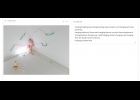“Devir em direção ao perecer”: Flusser, Plásticos, Rodas, e Inteligências Artificiais / "Becoming towards perishing": Flusser, Plastics, Wheels, and Artificial Intelligences
This essay proposes a digression on the permanence and impermanence, the visibility and invisibility of synthetic polymers (also known as plastics) and the role of AI, starting out from an interpretation proposed by Vilém Flusser in his essays “Forma e material” and “Rodas”. It explores the boundaries between form and matter, organic and synthetic, natural and artificial, art and science The text also includes a reflection proposed by Roland Barthes regarding synthetic polymers in his essay “Le plastique”, from the work “Mythologies”. The proteism of plastics could be interpreted as a utopia of total information. The text is accompanied by four images created by a Versatile Diffusion program.
Flusser's Take on Media Pedagogy
There is no non-medial perception. However, the apparatus producing techno-images tends to make us believe in something like an immediate perception. It suggests that we do not have to learn to decipher the programs behind those images. There is no possible revolution against this mechanism within the world it has created. We need to learn how to analyze these programs and to use them ourselves. Therefore, we need a pedagogy that is also - but not only - media pedagogy and exceeds the conventional realm of media literacy. Can any kind of pedagogy afford to exclude an aspect of the world as central as mediality? Media pedagogy should not be an addition to pedagogy but rather one of its integral parts. It has to teach a critique of images. We have to learn to distrust our own eyes. And we have to realize the slumbering potential for dialogue in the communication structures. We all have to become programmers. Otherwise society will decompose into factions of producers and recipients. And all of this will have to take place in our schools that otherwise will become obsolete and leave our children without the tools of understanding, criticizing and changing the world. Then, democracy would be no longer tenable.
Flusser Against Idolatry
The article, based on the author’s doctoral thesis “Vilém Flusser: a critic of idolatry in the age of new media”, analyses the concept of idolatry as a thread connecting Flusser’s early writings on religion with the later ones on communication. Studying his sources and the main occurrences of the term “idolatry” in his writings can help us understand Flusser’s original conception. The first uses of the concept (1963-1967) are clearly embedded in his Jewish education and appear mostly in the context of his essays on hierophany and secularization, especially the ones where Flusser posthumously argues with his mentor Vicente Ferreira da Silva. From 1978, “idolatry” appears in a new context, namely his essays on media theory and communication, in particular where image and text are confronted. By connecting these two phases we are able to read his communication theory in the light of his studies on religion, understanding the key role of the concepts of idolatry, magic and myth in his later texts.
The concept of idolatry allows Flusser to reflect on images beyond an aesthetic approach. Images are not only objects of contemplation: they act on us, modifying the way we look at the world and therefore our beliefs and our behavior. However, his theory is not apocalyptic: idolatry does not emerge automatically through contact with images, but it is caused by a reversal of imagination. Training our technical imagination will help us overcome the danger of a new idolatry.
Programing the Visible: Dialogues between Vilém Flusser and Harun Farocki
The 2016 São Paulo exhibition “Programando o Invisível” [Programing the Invisible], showcasing works by the artist and filmmaker Harun Farocki (1944-2014), questioned the role of images in the 21st century, and particularly those images constructed by computer algorithms for video games. One of the videos in the exhibition captured the dialogue that took place between Farocki and Vilém Flusser (1920-1991) in 1986. In this theoretically rich and promising video, titled “Shocking sentences, shocking images: a conversation with Vilém Flusser,” they discussed the hegemony of images and of their power in programing our visibility. The theme is one of the central questions in both their works, as if the filmmaker and the philosopher were speaking about the same thing, although in different and complimentary ways. Their works similarly urge a reflection about the possibilities of creation of a critical perspective in face of our image culture, and they both emphasize the question of freedom in a society increasingly programed and dominated by technical images.
Um diálogo entre Flusser e Heidegger: o ser no universo
To Flusser, technical images create different meanings and realities, leading to an inversion of our “being-in-the-world” to a “being-face-to-face-with-the-image.” In this situation, the distinction between real and imagined, then, would no longer make sense, since only the image itself becomes something concrete. Thus, according to the author, we end up facing back the objective world. Regarding this statement, we propose, in this paper, through a dialog between Heidegger and Flusser, a discussion about being in the universe of technical images.
Juego e imaginación en Vilém Flusser
In several texts Vilém Flusser argues that if we had to define some specificity that characterizes the human being nowadays it would be homo ludens, because of the multiple cultural revolutions that have occurred, which have radically altered man’s existence, especially his imagination. The argument outlined in this paper is that the category of play not only reveals a specificity of contemporary man, but also represents his philosophical gesture. It is a central notion for Flusser’s criticism of the apparatus as a technical device.
Los fantasmas de Flusser: de magia, comunicación e imagen visual
This paper focuses on the relation between technical image and magic, that is, between the post-historic and the post-magic era and the way it is treated in the philosophy of Vilém Flusser. The image as phantasmagoria is translated into a virtual spectrality, a game of signs and a circular concatenation as in the idea of the eternal return.
Bilder – Denken. Über die Notwendigkeit einer Philosophie der Fotografie
In this contribution Claudia Becker examines the necessity for a “Philosophy of Photography” Flusser proposed in the 1980s. She expounds the problem that there is no deeper reception of his thought in the various discourses of the pictorial turn or media philosophy, even though Flusser can be read as one of the first who proclaimed a philosophy of (technical) images. She takes a closer look at the propositions of what Flusser calls a philosophy of photography and correlates them with other famous thinkers and philosophers.
De Flusser a Benjamin – do pós-aurático às imagens técnicas
This text presents some elective affinities and differences between the works of two powerful media theoreticians of the 20th century: Water Benjamin and Vilém Flusser. Both authors have shaped original perspectives on the relationship between art and technology. While holding a special place for the theory of photography, both have reflected upon the history of writing and its transformations during Modernity. In addition, both Benjamin and Flusser dedicated important texts to the question of translation and the philosophy of language. This text also examines the differences between the Benjaminian theory of writing and image reproduction connected to his concept of post-auratic images, and, on the other hand, the Flusserian theory of technical and post-historical images.
Vilém Flusser e a Terceira Catástrofe do Homem ou as Dores do Espaço, a Fotografia e o Vento
Vilém Flusser’s contribution to modern Media Theory might have found a possible synthesis in his text “Nomadic Reflections” presented in one of the ‘Kornhaus-Seminare’ organized by Harry Pross, on the subject of Euronomadism. Flusser presents a division of the history of humankind into three great catastrophes: humanization, civilization and a third catastrophe, still nameless. This last one that is occurring now will turn humankind back to nomadism. Wind, the desert, granules and emptiness become again decisive categories for the communicative behavior of humankind, already perceivable through photography and technical images. Things and their materiality lose in value, non-things and their immateriality gain in value.




